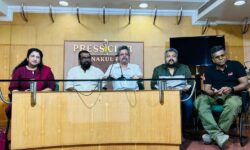KOCHI:
The environment in which one grows can wield a strong influence in the subsequent artistic practice, going by the cases of Akshay Chari and Mucharia Madhukar. The two youngsters from Deccan use techniques from their family’s traditional occupation to express ideas that also serve as relevant links to modern times.
The Students’ Biennale has their works being exhibited in the heritage town of Mattancherry, where renowned artist K P Reji is the curator.
Akshay hails from a Goan family of carpenters and has his work focusing on rampant ecological destruction of his tiny land defined by beaches and boulders. At KVN Arcade amid the fourth edition of the Kochi-Muziris Biennale, the youth has created a hilly terrain using hammered metal nails onto a carved wooden surface.
The work, titled ‘When the Mountain Falls’, talks about Goan landscape perishing owing to mining and deforestation. The artist essays how man’s greed has spawned hunters of iron and timber in the little state by the Arabian Sea.
Akshay, who hails from a small Goan village called Canacona, was exposed to the skills of carpentry from an early age. As he grew, the artist broadened his themes but continued to be inspired from his household vocation. “You know carpentry is an art backed by meticulousness. You need patience and creativity,” he notes.
Into his adulthood, Akshay began getting increasingly interested with the idea of tracing generational advancements in carpentry, courtesy modernisation. In fact, some of Akshay’s early work had been a take on how new-age carpentry has become highly technology-dependent.
Proceeding with the profile, his work in Kochi (on till March 29) has the act of hammering nails working a “metaphor of authorities covering their tracks” and “creating a hoax vision of things being in order”. The mountain of nails also represents the huge stockpile of iron ore that has lately become a common sight across Goa in contrast to its traditional looks steeped in greenery and cleanliness.
“My work is also a result of my fascination towards several traditional carpentry tools my ancestors used, but today remain idle in my house. Somewhere along the way, they were all abandoned,” shrugs Chari, an alumnus of the Goa College of Arts. “For me now, they are like windows to our past. They allow us to provide a tangible link between us and the people of past societies. Call it museumisation of a sacred heritage.”
The Students’ Biennale has another such work that is inspired from the artist’s fascination for his hereditary work. Titled ‘Baba Saheb’, it is done by Mucharia of Telangana and is being exhibited at a venue called Mattancherry Temple.
Mucharia, who studied at Potti Sri Ramulu Telugu University in Hyderabad, belongs to the cobbler community of Madikas from a village in the nascent Dravidian state carved out of Andhra Pradesh. He uses leather as his chief medium of artistic expression.
“I explore more about portraiture with the help of natural pigments used on leather,” says the artist, whose work here features a portrait of 20th-century social reformer B R Ambedkar, who has been a beacon of life for the country’s marginalised masses.
According to Reji the curator, Akshay’s work highlights the vitality of ‘precision’ in carpentry. “It’s a hypnotic act that requires immense patience,” he notes. “Even if it comes to you hereditarily, carpentry warrants so much of concentration and effort to attain perfection.”
As for Mucharia’s work, Reji calls it a “perfect example” of the Students’ Biennale theme: Making As Thinking. The young artist “explores those objects that were lying lifeless in his drawers used by his ancestors for generations,” adds the curator.




